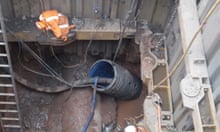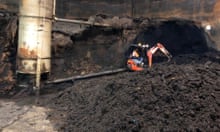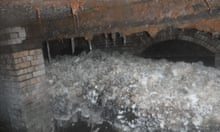A 10-tonne lump of wet wipes and fat has been removed from a sewer in Chelsea, west London.
The toxic lump of congealed fat and household waste – known as a fatberg – was 40 metres long and so heavy that it broke the 1940s-era sewer.
Repairing the damaged sewer is expected to cost Thames Water £400,000 and take more than two months, the company said.
Stephen Hunt, a repair and maintenance supervisor at Thames Water, who is overseeing the fatberg’s removal, said its size was staggering.
“We see blockages all the time on household sewer pipes, which are about big enough for a cricket ball to pass through, but to have this much damage on a sewer almost a metre in diameter is mind-boggling.
“The original sewer has been so badly abused by fat being chucked down the plughole we’ve had to opt for the time-consuming and disruptive option of replacing many metres of pipe.”
Fatbergs – formed when fat clumps together with other household waste – are becoming an increasing problem for London’s sewers.
The capital, which has the highest concentration of food businesses in the country, produces an estimated 32m–44m litres of used cooking oil every year, much of which is poured down drains. The use of wet wipes as toilet paper is also increasing, exacerbating the situation.
In 2013 a fatberg weighing 15 tonnes was found in Kingston, and last year workers spent four days clearing an 80-metre-long fatberg from underneath Shepherds Bush Road.
Thames Water began battling the Chelsea fatberg – which had been lurking two metres under Draycott Avenue and Walton Street – in March. So far the company has replaced 22 metres of broken sewer with new piping, with another 17 metres left.
The team is having to dig down by hand due to the number of other pipes in the earth below the street.
“I’d urge people to consider what lurks beneath their feet,” said Hunt. “When it comes to getting rid of fat, ‘bin it – don’t block it’.”
One in five people admit flushing wet wipes down the loo, according to research by Thames Valley. The company warns that doing so creates “a nasty solid mess” and risks sewage flooding homes.
The water company dealt with 200,000 blockages in the last five years, with 18,000 homes flooded with sewage. Across its region, it says Ealing, Hounslow and Harrow are blockage hotspots.









Comments (…)
Sign in or create your Guardian account to join the discussion